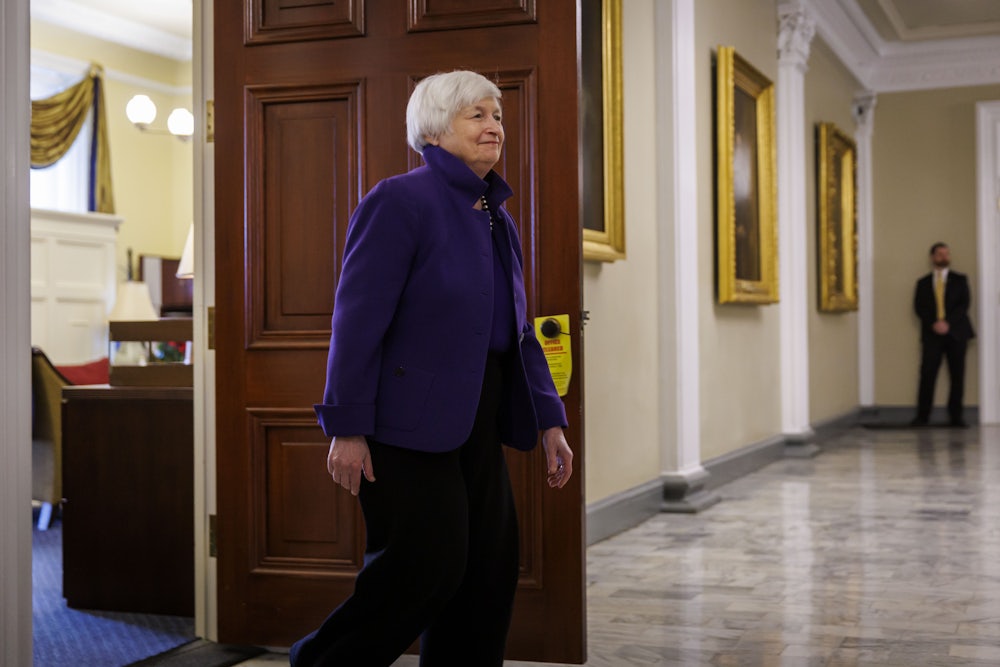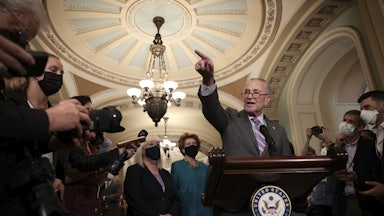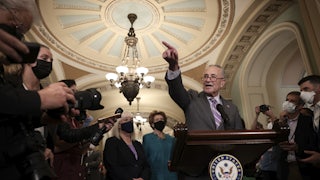For a little more than a year, the looming partisan fight over the debt ceiling hovered over the nation’s economic future, lurking just out of sight like a monster in a horror movie or Jason Momoa on a red carpet—an inescapable problem that has not yet arrived but is destined to knock you (or the global economy) over with unsettling speed.
After a bracing fight in the fall of 2021, Congress raised the debt ceiling by $2.5 trillion, ensuring that the country would not hit its borrowing limit until 2023. But future problems have a way of transforming into current ones with the passage of time: On Friday, Treasury Secretary Janet Yellen told congressional leaders that the country is expected to hit the statutory limit of more than $31.4 trillion this week, forcing the government to employ “extraordinary measures” to avoid default. But in practice, the measures don’t seem so extraordinary: They are merely the equivalent of extending a deadline. As Yellen noted in a letter, it “enables the government to meet its obligations for only a limited amount of time.”
“While Treasury is not currently able to provide an estimate of how long extraordinary measures will enable us to continue to pay the government’s obligations, it is unlikely that cash and extraordinary measures will be exhausted before early June,” Yellen wrote. Thus Congress, world-renowned for its speedy problem-solving, has only a few months at best to figure out a solution.
The debt limit has become a ticking time bomb that comes close to exploding roughly every two years; the perennial courting of significant economic risk is now a commonplace affair. But that biannual showdown now features some new complications: a divided government and a turbulent House Republican conference. Speaker Kevin McCarthy secured support for his speakership candidacy earlier this month from a faction of conservative lawmakers in part by promising massive spending cuts to balance the federal budget. But McCarthy only became speaker after 15 votes, unprecedented in the modern era and worrisome to political observers who fear that the five-seat GOP majority in the House may not be able to hold together on key priorities such as funding the government or, say, raising the debt ceiling.
“It’s not time to panic yet. Congress has ample time to address this in a way that will not pose a significant risk or costs to the U.S. economy,” said Shai Akabas, the director of economic policy at the Bipartisan Policy Center, a Washington think tank. “But the events of the past few weeks have certainly been disconcerting for those of us who are looking ahead to later in the year because it shows a very heightened level of political discord even within the Republican Party about how they’re planning to address this issue.”
It’s been a while since you’ve had to think about all of this, so let’s take a pause here. To recap: The debt ceiling is the limit for the federal debt, including both publicly held debt and debt held by government agencies. Unless the limit is lifted through legislative action, the Treasury Department will not be able to borrow any more money to cover spending already approved by Congress. Raising the debt ceiling does not authorize new spending.
It’s unclear what happens when the country reaches the “X date”—the day on which extraordinary measures run out and the country risks default on its debt—but economists warn that it could send the U.S. and global economies into a tailspin. A default would likely spark panic on Wall Street and could push us into a recession, resulting in millions of job losses. The Treasury Department would be unable to make payments on Medicare and Medicaid, Social Security, military pay, and veterans’ benefits, to name just a few programs critical to our nation’s functioning. On a global scale, it could mean a loss of faith in the American dollar and threaten our status as the world’s reserve currency. Even just getting close to the X date could lead to a downgrade in the country’s credit rating—as happened during the debt ceiling fight of 2011—as well as higher interest rates for American taxpayers.
Although raising the debt ceiling was never truly free of partisan considerations, the showdown in 2011 brought it to new levels of political toxicity. “Our politics has become desensitized to how much of a threat this really is. We’ve become so used to this brinkmanship,” said Laura Blessing, a senior fellow at Georgetown’s Government Affairs Institute. Blessing noted that the country came roughly as close to its X date in 2021 as it did a decade earlier, in 2011.
While American debt has ballooned to almost comic levels in recent years, leveraging the debt ceiling in exchange for spending cuts has not historically resulted in fiscal restraint; the last time Congress actually lowered the debt ceiling was in the mid-twentieth century. Moreover, the fights over the debt limit in 2011 and 2013 did not result in the grand deficit reduction for which Republicans had hoped. Then there’s the issue of politics: Cutting Social Security or Medicare may not be a winning campaign message for Republicans in 2024. (We should also recall that despite pleas for fiscal restraint, Congress lifted the debt ceiling three times under President Donald Trump, a Republican.)
“For all the Republicans who think that this is some sort of silver bullet to engender a massive spending cut plan—I don’t have a crystal ball, I can’t say that this is never going to function that way. But historically, that has never been the pattern,” Blessing said.
As part of the private deal between McCarthy and conservative members that resolved the speakership stalemate, House Republicans are reportedly considering a strategy of “payment prioritization” should the country default on its debts, according to The Washington Post. This would mean that Congress would provide the Treasury Department with a plan to fulfill the most crucial payments. This would likely include continued interest payments on the country’s debt; Congress might also ask the Treasury Department to continue fulfilling Medicare, Social Security, and veterans’ benefits payments, as well as military funding.
But prioritization of certain programs necessarily means that others would fall through the cracks: Medicaid, for example, as well as border patrol and air traffic control. (Republican Representative Tom McClintock recently reintroduced a bill first released in 2011 allowing the Treasury Department to continue to borrow to pay interest and principal due on the debt no matter what, but it’s unclear whether this bill has sufficient support, even from his own conference, to pass.)
A prioritization plan was considered during the debt ceiling crises of 2011 and 2013, but the Obama administration argued that it would be difficult to prioritize certain payments on such a large and complex scale. Moreover, such a plan by House Republicans would need to be approved by the Democratic Senate and signed by Biden.
“Is it a more serious idea than the idea of a trillion-dollar coin? Sure. But this is something that would be highly experimental, and it’s probably going to create a really unacceptable level of risk to both domestic and global financial markets,” said Blessing, referring to the somewhat ironic proposal of minting a trillion-dollar coin to pay off the country’s debts. “You’re getting into different levels of disaster by the time you’re seriously considering that. I hope people don’t seriously consider it, because I’m not hoping to have a lower level of disaster.”
With a divided government, a debt-limit showdown is all but inevitable. “We’re not going to do any negotiations. And it should be, again, done without conditions,” White House press secretary Karine Jean-Pierre said last week, highlighting Democrats’ preference for passing a “clean” debt ceiling increase. In a joint statement on Friday, Senate Majority Leader Chuck Schumer and House Democratic Leader Hakeem Jeffries said that “Democrats want to move quickly to pass legislation addressing the debt limit so there is no chance of risking a catastrophic default.”
However, Democrats may have no choice but to come to the table. “I want our side to negotiate with the Democrats in good faith, but President Biden has to also negotiate. He can’t say he refuses to negotiate. That’s a nonstarter as well,” moderate Republican Representative Don Bacon told ABC News on Sunday.
Moderate House Republicans have insisted that the country will not default on its debt. Some lawmakers have floated the idea of using a discharge petition, theoretically allowing a faction of Republicans to team up with Democrats to circumvent party leadership and force a floor vote on a debt ceiling increase. But using a discharge petition is a complicated process, and one that requires significant chunks of time that Congress may not have.
The fracas over the debt limit highlights the seeming inability by Congress to address an untenable fiscal situation. Setting aside the merits of their more expensive legislation, both parties have been profligate in their spending in recent years, resulting in a deficit that measures in the trillions. But risking catastrophic default on a biannual basis is perhaps not the most responsible method of forcing a discussion on government debt. The 2011 showdown resulted in the creation of a “supercommittee” to determine how to balance the books. But to keep things short and sweet—or, I guess, just less long at this point—Democrats didn’t want to cut entitlements, and Republicans didn’t want to raise taxes.
Even if Democrats and Republicans sit down for a serious conversation on fiscal responsibility (pause here for the laugh track), there’s still the question of how to address the debt ceiling. Some members of Congress support abolishing it altogether. There’s also bipartisan legislation to reform the debt ceiling process by allowing for a debt-limit increase to be authorized every time Congress passes a budget—essentially the same as the so-called Gephardt rule of yore—or require the president to ask Congress to suspend the debt limit with an accompanying debt-reduction proposal. But it is uncertain how much traction this idea could gain in a divided Congress, or even within a fractious Republican majority in the House.
With roughly five months to go until the X date, members of the 118th Congress will need to decide whether they are willing to seriously address the problem of the debt ceiling and the underlying issues of federal debt, or whether they are willing to bring the country to the brink yet again as they play a dangerous game of fiscal chicken.
“I think it would be more productive for our leaders on both sides to be discussing ways that we avoid these potentially catastrophic scenarios rather than trying to prescribe which potentially catastrophic scenario we undertake,” Akabas told me. “I think the focus should be on: How do we address fiscal policy, and how do we ensure that we are meeting all of our obligations? Not: Which of our obligations should we be failing?”










